Imagine logging onto your favorite eCommerce site and being greeted by a friendly, conversational commerce message, welcoming you to the store.

You begin browsing. You’re not entirely sure what you want, but Mother’s Day is coming up, and you’ve been trying to find that perfect give for your mom.
After a few minutes of searching, another message pops up, asking if you need help finding anything.

You type a reply: “I’m looking for a Mother’s Day gift.”
A response comes back immediately: “I love picking out gifts! May I help you find something?” It includes buttons for either yes or no. You click yes.
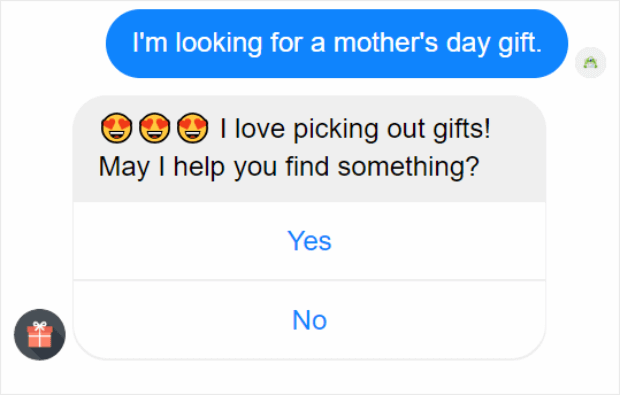
You’re asked a few questions about your mom’s personality and then shown a few different gift ideas. A couple of them are actually pretty perfect for her. You select the gift you want and complete your purchase, all without ever leaving the chat screen.
You just experienced conversational commerce.
In this post, I’ll explain the meaning of conversational commerce and discuss its benefits. I’ll also share examples of how to use it in your eCommerce marketing.
- What Is Conversational Commerce?
- 4 Statistics on the Impact of Conversational Commerce
- Why Use Conversational Commerce?
- 6 Conversational Commerce Examples
Add a Live Chat Plugin for Your Site!
Check out our guide to the 13 Best WordPress Live Chat Plugins
What Is Conversational Commerce?
Conversational commerce refers to the use of chat and voice technologies, sometimes powered by artificial intelligence, to facilitate direct interactions between online shoppers and brands. This approach lets businesses provide personalized assistance, answer questions, and improve the overall online shopping experience.
Conversational commerce creates a digital environment that mimics having a sales assistant in a physical store. It allows online stores to overcome customer objections in real-time and drive more immediate sales.
As messaging apps continue to grow in popularity, chatbots and similar tools have gained significant traction. These tools allow eCommerce retailers to engage with customers at every stage of their customer journey.
Types of Conversational Commerce
- Chatbots: Automated systems that interact with customers via text or voice to answer questions, recommend products, or complete purchases. Chatbots are generally used on the business’s website or app.
- Live chat: Real-time text-based conversations between customers and human agents on a website or app, allowing for immediate support and personalized assistance during the shopping process. Live chat is also accessed on the business’s website or app.
- Social media messaging: Platforms like Facebook Messenger and WhatsApp where businesses can interact with customers directly, providing support and promotional offers. Social messaging can be done through a chatbot or with live agents. This type of conversational commerce meets potential customers where they already are: on social media platforms.
- Voice assistants: Devices like Amazon Alexa or Google Assistant that enable users to make purchases or get information through voice commands. Voice assistants are triggered on customers’s own devices.
4 Statistics on the Impact of Conversational Commerce
Is it worth it to invest in conversational commerce platforms?
Here’s some data that shows the powerful impact of conversational commerce:
1. Convert 82% of Social Chats into Sales
The chatbot platform Spectrm published a 2023 State of Social Conversational Commerce Report. Among users who chatted with a brand via Facebook Messenger, Instagram, or WhatsApp, 82% went on to make a purchase with that brand.

How many places can you get that kind of conversion rate?
2. Earn More Trust from 95% of Consumers
In their ebook Conversational Messaging: The Next Storefront Experience, Twilio finds that 95% of consumers trust brands more if they can easily initiate a conversation with them. To earn this trust, you need to make it easy to start a chat wherever that customer is, including on your website, mobile app, and social media channels.
3. 80% of Consumers Report Positive Chatbot Experiences
The marketing platform Uberall surveyed 1,000 U.S. adults about their experiences with chatbots. 80% reported that their experiences with chatbots have been generally positive. The quality of chatbots has been improving drastically with advancements in AI, making them a more helpful option for customers.
However, the same report says that only 14% called their chatbot interaction “very positive,” which brings me to the final statistic.
4. Nearly All Customers Prefer Live Chat Over Bots
According to a 2021 report by Simplr, 95% of chatbot users say they would have had a better experience chatting with a human. Chatbots are incredibly helpful for offering immediate 24/7 support with no wait times. However, if you have the resources to give the option to chat with a live agent, you’ll end up with happier customers.
Why Use Conversational Commerce?
The data above provides a strong argument for using conversational commerce. But the benefits all come down to a single primary purpose: providing a better, more personalized user experience.
After all, 73% of customers say that customer experience is important to their purchasing decisions, according to a report by PwC. The only factors ranked as more important were price and product quality.
Ultimately, using tools like chatbots to engage with our customers should add to their experience, not detract from it. And, when used correctly, that’s exactly what it does. In turn, it benefits you by driving more sales.
1. Direct Line to Your Audience
When you’re active on social messaging platforms, you’re able to meet your customers where they are. As we mentioned earlier, messaging app usage has surpassed that of social network usage, so when you reach out to customers via Facebook Messenger with an ad they’re more likely to see it than a standard Facebook ad.
Chatbots offer you a direct line to your shoppers and, importantly, give them a direct line to you.

Shoppers who don’t get enough support during their experience are way less likely to buy something.
Think about our story at the beginning of this article. What if our chatbot hadn’t popped back in to check on you while you’d been shopping? Would you have stuck around, browsing aimlessly?
You probably would’ve bounced and gone to another site where you’d either found what you wanted on your own or another, more helpful chatbot had found it for you.
Chatbots can provide proactive support like you’d find in a brick-and-mortar store and help the customer feel confident enough to make a purchase.
2. It’s Cost and Time Effective
Chatbots are both cost and time effective. They can help with simple customer questions while your employees tackle more complex matters.
And, a single chatbot can handle nearly an unlimited amount of interactions all at once. Humans… not so much. Fortunately, what we lack in multitasking capabilities we more than make up for in cognitive reasoning.

Bots can also be up and running 24/7. Human support can be too, but it’s expensive to staff customer support around the clock.
Are we saying that chatbots are a replacement for humans? Again, no. We are saying that chatbots can be incorporated into your service and marketing strategies to increase their effectiveness and return and make everyone happier.
3. Lead Generation
Conversational commerce doesn’t have to be solely about making the sale. Not directly.
Casper Mattresses created Insomnobot-3000, a quirky little chatbot that you can text with when you can’t sleep.

This is an excellent example of how chatbots can be used for lead generation. Casper not only receives a potential customer’s mobile number, but they’re also getting text messages that contain a goldmine of psychographic data.
With better, more complete information about your potential customers, you can create targeted marketing campaigns that include high-converting personalization techniques like including your lead’s name, location, or recommending a product they’ll probably like.
6 Conversational Commerce Examples
Are you ready to see conversational commerce in action? Here are some ways you can use conversational commerce to engage with your customers.
1. Connect With the Customer on Facebook Messenger
Let’s say that you have chat set up on Facebook but don’t have it available on your website. You can simply direct website visitors to use your Facebook chat. In our Facebook Messenger marketing tutorial, you’ll learn how to create an OptinMonster popup that lets website visitors access your Facebook chat in one click.
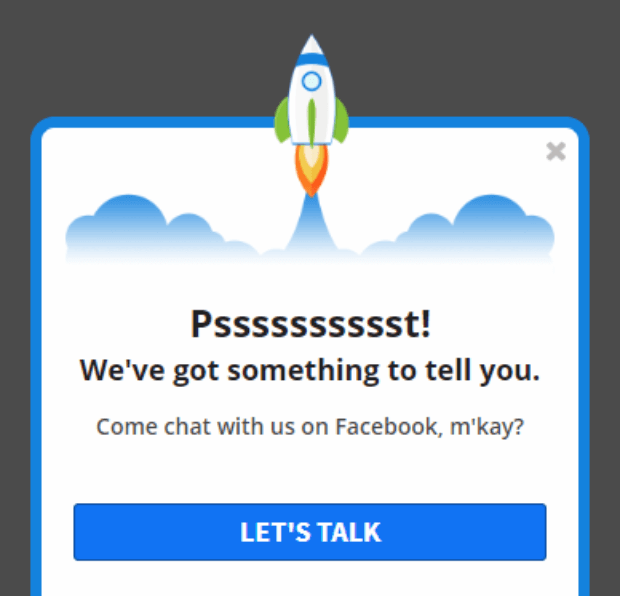
This tutorial came to us as a request from one of our customers who was looking for ways to drive their own customers from their website to their Facebook page where they actually had the ability to engage with them.
When the business is open, customers can engage with employees in real time, but after business hours you can set up your chatbot to handle simple questions and requests.
Turn Your Website Visitors Into Customers!
With OptinMonster’s popups, floating bars, and other onsite campaigns, you can show your best offers to the right people at the right time.
2. Chat with the Customer From the Online Store

You can use this approach to automate responses to customer questions about sales and specials, products, or any other steps in the customer journey.
Customers can also be connected to a human if they need support with a more complex issue.
3. Recover an Abandoned Cart

Nobody likes abandoned carts. A great step toward recovering them is reducing abandoned carts to begin with. You can write a chatbot to remind shoppers about items they’ve left in their cart. You can add a link to the checkout page or let them check out right in the chat screen. You can even give them options to ask a question or get a reminder the next day.
If this chat reminder doesn’t work, you can use abandoned cart recovery emails to continue nurturing those shoppers.
4. Confirm the Customer’s Order
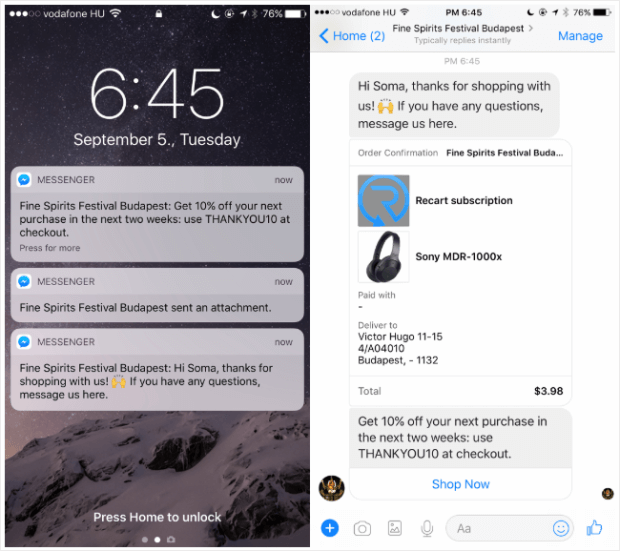
Customers expect to be notified of their purchase pretty much as soon as they press the “Complete Purchase” button.
Sending notifications in messaging apps like Facebook Messenger keeps them updated and lets them request future updates related to their order that they know aren’t going to end up in their email’s spam folder.
5. Create a Positive User Experience
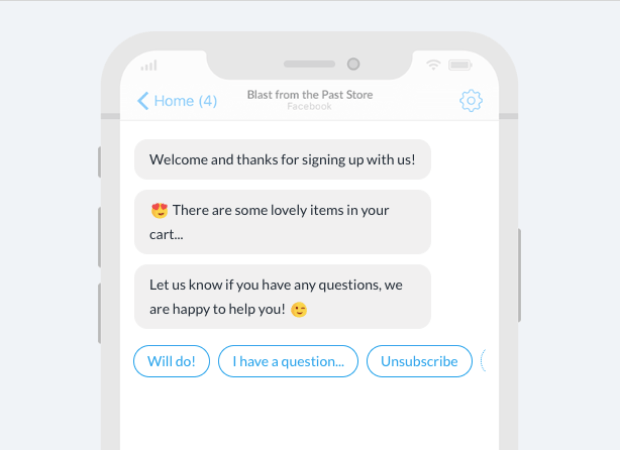
You can use conversational commerce to create a positive user experience just to generate some goodwill between you and your customers. This is a really easy way to add a personal touch. If the customer comes back with a question that your chatbot can’t handle, one of your human associates will be able to get it.
Chatbots give you the chance to be a bit more informal and personal than even email communications. While emoji have only recently found their way into email subject lines, people almost expect stickers, emoji, and GIFs in messenger app messages.
6. Ask for a Product Review
Product reviews are so important to increasing social proof and, by extension, conversions. You can use conversational commerce platforms to easily get more reviews.
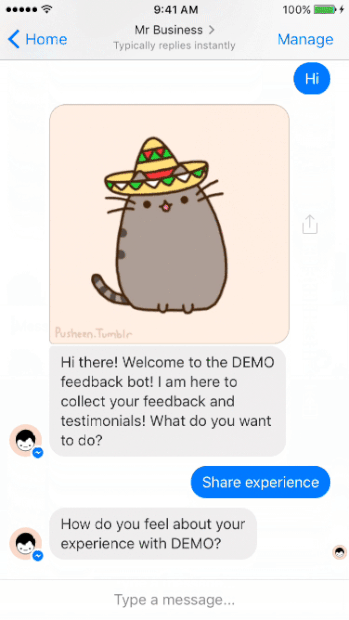
Ask for things that can be answered easily from a mobile phone:
- Satisfaction with product or shopping experience on a scale
- Picture or video of the customer using the product
- Shoutout on social media using a specific hashtag
- Short review
- Video testimonial
Transform Customer Experience With Conversational Commerce
When you include conversational commerce in your eCommerce strategy, you can improve customer experience, drive sales, and build brand loyalty. Chatbots, live chat, and social messaging let you engage with customers in a more meaningful way, which boosts your brand’s reputation.
If you want to learn more about using chat for your marketing, here are a couple of helpful resources:
As you consider implementing these tools, remember that OptinMonster can help you capture leads and recover abandoned carts with ease.
With our powerful popups and other onsite campaigns, you can effectively engage your audience and transform them into loyal customers. Get started with OptinMonster today and take your conversational commerce efforts to the next level!

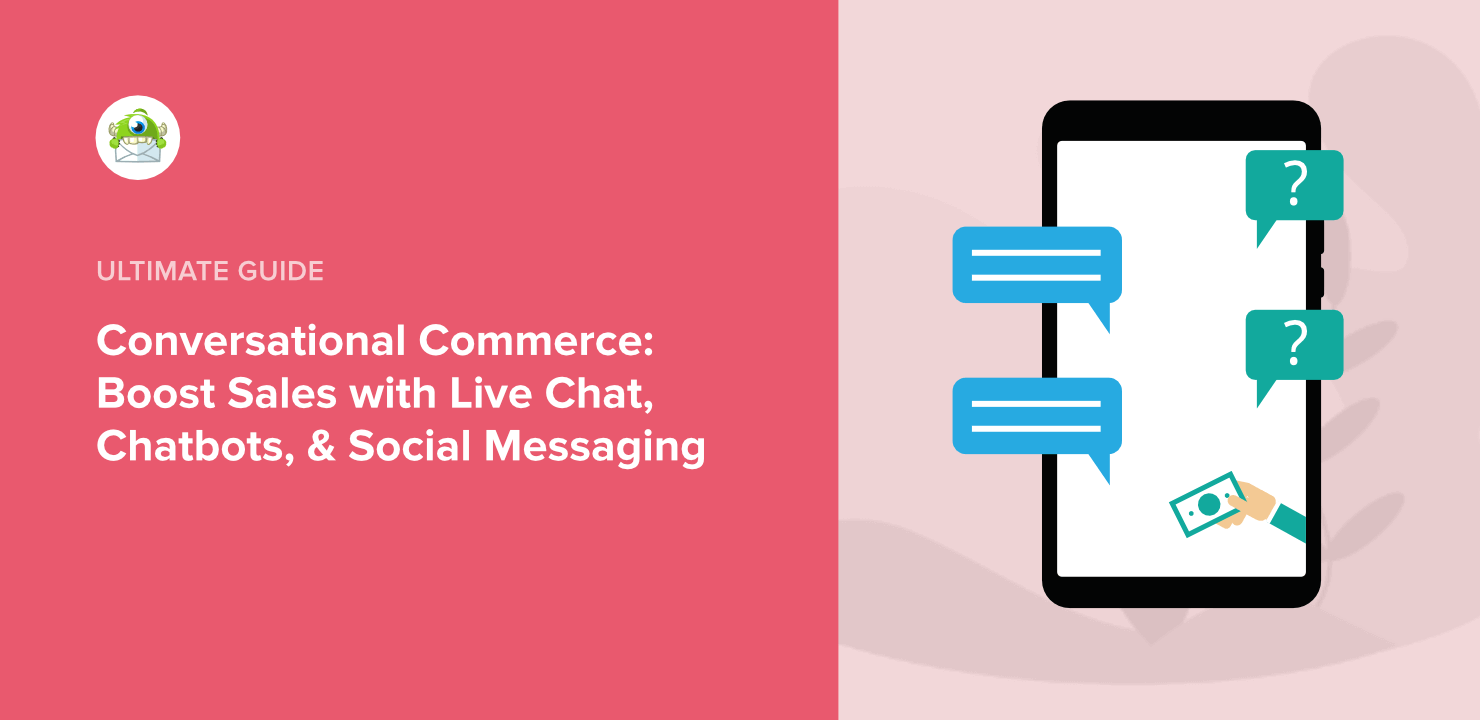
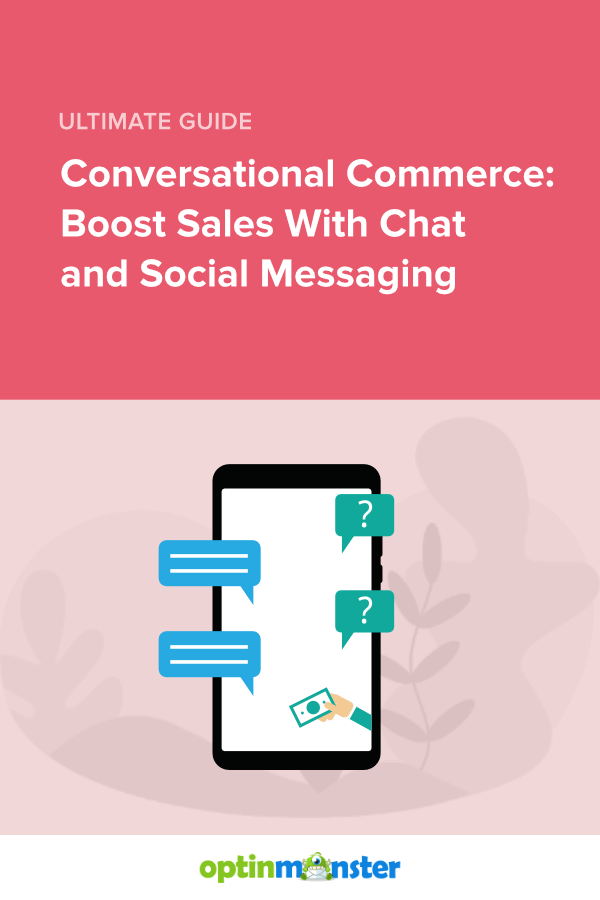








Add a Comment